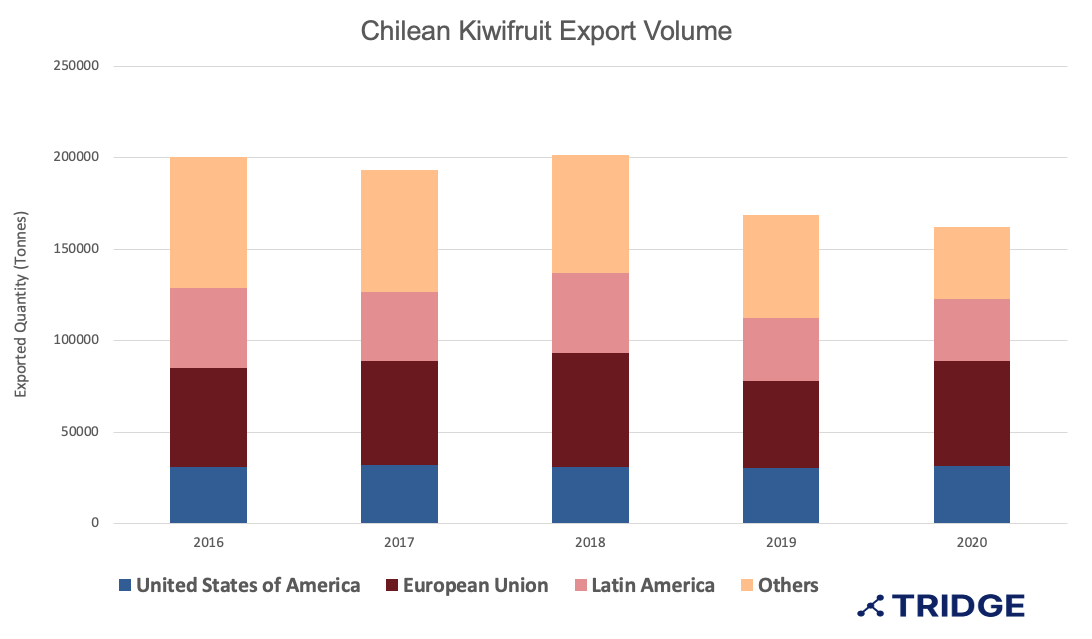Exports of Chilean Kiwi to the US in Full Swing
Demand in the US for Chilean Kiwis has been consistently strong throughout the season, but delays in shipments within the first half of the season have caused prices to rise. Nevertheless, the export volume has recovered substantially in recent weeks, making up for the scarce supply at the beginning of the season.
Making up for a Slow Start
According to the Chilean Kiwi Committee, export volumes to North America have increased by 20% from 2020, with 19,439 tons shipped through week 29. However, due to a slow start to the harvest in Chile, the season started the opposite way for the first half of the season, with a considerable decrease in volume. This season, Chile started shipping kiwis to this market by week 8, same as the previous season, with fruits from early varieties such as Green Light, Dori, and Soreli. The difference was that for this season the supply was shorter than in previous years.
According to the Committee, by week 18, 35,436 tonnes of kiwis were shipped to the US, a decrease of 16% from the same period last year, and by week 21, shipments were 21% lower than the previous season, causing prices to rise by 15% of the prior year. However, by week 29, the Committee reported that shipments have started to flow at a faster pace, as exports in Chile are now focused on their second-largest market, the US. This is because the decrease in production caused delays earlier in the season and the first available fruit was consigned to Latin American markets and then Europe, which is Chile’s largest market.
Weather Conditions Allowed an Extended Supply
This season has been characterized by a decrease in the volume of fruits to the market and a delay in harvest due to COVID-19, which has altered the pace of work, limiting the availability of labor in Chilean production areas, causing a drop in production and delayed harvest. The Chilean committee has reported an estimated 10% to 15% decrease in this year’s production volume. However, the cool summer that the South American country has experienced has also led to excellent storage conditions, which has allowed further extending of supplies.
A mild summer season has led to the harvesting of the kiwifruit with good soluble solids and dry matter, which has ensured excellent storage conditions and allowed for an extended supply. This has caused the shipping season to be extended for a few more weeks and a consistent increase in volume in the remaining weeks of the season. This will allow the US and the European markets to recover their kiwi supply and ease pressure on prices that were reported to be reaching a historic high last May.

Source: ITC Trade Map, Tridge
Positive Close of the Season Projected
The exported volume projected for this season is expected to reach 145,000 tons of kiwifruit. According to the Chilean Kiwi Committee, 110,624 tons in total have been shipped so far, 76% of the projected volume. With about four weeks more to go into the export season, the projected volume is expected to be easily met, maybe even beyond. Last season 146,323 tons were exported, which means this season’s numbers will be very similar even with the production challenges presented. For this season, the committee has announced that Europe has taken 38% of shipments, while Latin America, North America, and Asia have taken 21%, 17%, and 16% of Chile’s export total respectively.
It seems that the overall quality and condition of the fruit might increase the volumes over last season despite delays and production decreases. Another factor that can be attributed to the positive closure of the season has to do with the marketing campaign that the Committee launched two years ago. Chilean kiwi has been strongly promoted among retailers and consumers through marketing campaigns and retail programs that have allowed the Chilean fruit to expand its consumption in North America.
Sources:
- Fresh Fruit Portal. "Chilean kiwifruit exports to North American up by a fifth."
- Fruitnet. "Chilean kiwifruit in strong demand."
- Produce Blue Book. "Chilean kiwifruit exports start slow."





